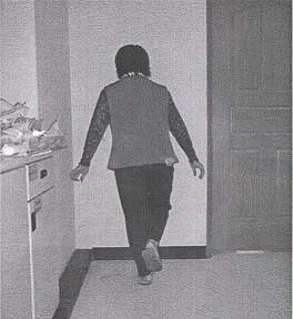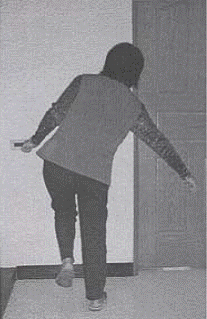篇名
Case 68
說明
| 今日案例: 外傷後,右腳單腳站立時身體無法平衡… |
敘述
小珍,女性25歲,外傷後,用左腳單腳站立時,身體可以保持平衡(如圖1),但用右腳單腳站立時,出現Trendelenburg sign陽性表現(如圖2)
 圖1 |
 圖2 |
請問
一、初步診斷為?二、Trendelenburg sign陽性意義?
解答
一、初步診斷:右側臀中肌無力二、Trendelenburg sign陽性:多見於臀上神經損傷(superior gluteal nerve damage)引起髖關節外展肌--臀中肌與臀小肌麻痹(paralysis of abductor muscles of the hip: the gluteus medius and minimus muscles);此外,髖關節脫位、陳舊性股骨頸骨折、先天性髖關節脫位也可陽性。
說明
臀中肌與臀小肌(gluteus medius and minimus m.)兩塊肌肉是我們走路站立時保持良好姿勢的重要肌肉,起於髂骨翼外面,止於股骨大轉子。是髖關節外展肌,並參與外旋及伸髖關節動作。在站立時,此二肌可穩定骨盆,從而穩定軀幹;在走路時,保持軀幹直立,髖相對固定,在提腿跨步時由臀中肌和臀小肌收縮將骨盆抬高(The gluteus medius is very important during the stance phase of the gait cycle to maintain both hips at the same level);單腳站立時,臀中肌和臀小肌收縮,將對側骨盆抬起,身體的重量會轉移到站立腳上,以便將重心轉移,才能保持身體平衡(Normally, the body shifts the weight to the stance leg, allowing the shift of the center of gravity and consequently stabilizing or balancing the body)。當某患者,以其患肢站立,因臀中肌和臀小肌鬆弛,當想要健側屈髖屈膝上提時,身體無法將重心轉移到站立腳上,反而健側骨盆下降,此為Trendelenburg sign陽性(when standing on one leg, the pelvis drops on the side opposite to the stance leg.The weakness is present on the side of the stance leg)。關鍵詞
右側臀中肌無力、神經損傷、關節脫位、臀中肌、臀小肌、病例分析研究室
上一篇
下一篇



